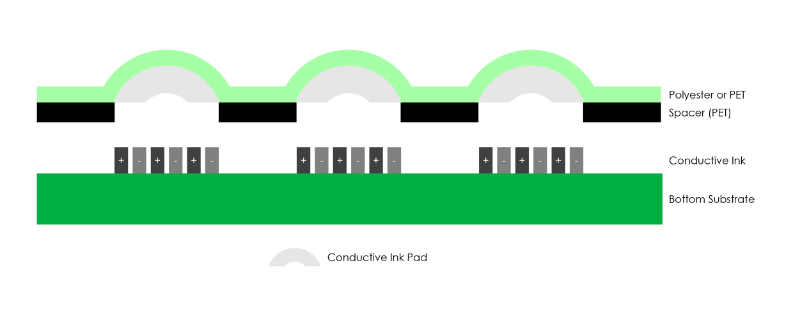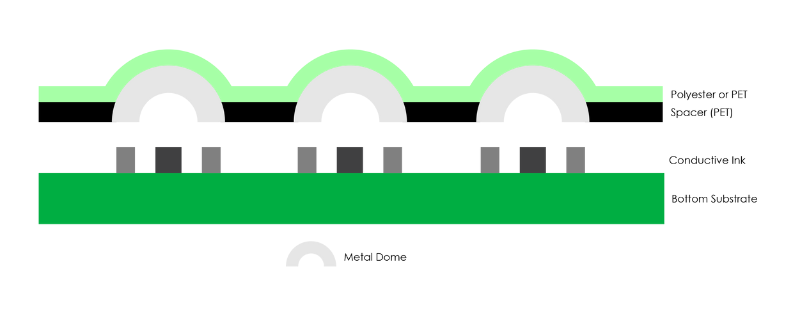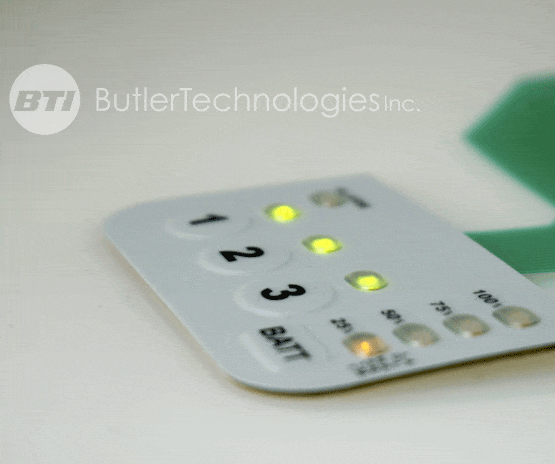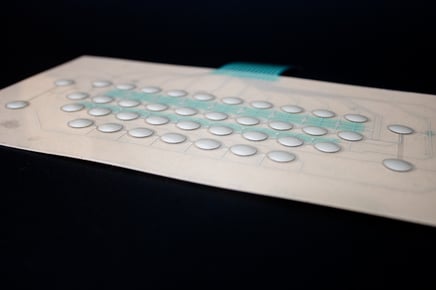Membrane switches are an innovative user interface design for many different reasons. An innovative feature of the membrane switch is the dome construction. Typically, membrane switches contain metal domes. However, a polydome design has no moving pieces or metal domes. Polydomes switches are also known as polyester dome switch membranes or PET switches.
A polyester dome switch is when the polyester overlay is formed with conductive ink. The polyester provides a quick snap when pressed.
PET
switches can give a more innovative tactile feel to your products. Their construction is a design feature that has excellent benefits, too.
What are Polydome Membrane Switches?
Polydomes refer to the part of the interface that the user interacts with. A polydome is a layer of embossed polyester with conductive ink. This layer of material is used as the top circuit of a membrane switch.
Unlike the traditional membrane switches, polydome switches do not include any metal domes within the interface design. Polydomes have conductive ink on the back and work the same as a metal dome.
The polyester, or PET, is formed to create a stiff plastic dome. When the stiff polydome is pressed, the conductive ink on the back of the polydome connects with the bottom layer of the circuit. This connection creates an electrical signal that gets relayed back to the interface’s PCB board or other computer parts.
Advantages of Polydome Switches
An advantage of using polyester dome membrane switches is that polydomes only require a light force for actuation. Since the polyester doesn’t need much pressure to be activated, they are also relatively quiet.
The high-quality materials used in polyester switches create a smooth and reliable interface. Polyester is very popular in interface devices because it provides a layer of solid protection to the display. Many engineers trust and rely on polyester because it can give a longer life span than other materials used in the industry.
A polydome membrane switch has no moving parts like a metal dome. Since the button is formed into the interface, it offers a long life that is easy to clean and durable against the constant use of cleaners.
Layers of a simple Polydome Switch
The top layer of a polydome switch is polyester or PET. This control layer gets formed or embossed into a round button shape.
Right under the PET is a little dollop of conductive ink, usually carbon or silver. This can be referred to as the top part of the printed circuit.
Many of the polydome switches also have another layer of PET to create a space between the layers of conductive ink.
The bottom layer of a membrane switch has conductive ink traces that create the printed circuit’s bottom layer.
Layers of a simple Membrane Switch

The top layer of a membrane switch is a graphic overlay. A few different kinds of materials are used for graphic overlays, but polyester is a common choice. Sometimes the buttons on the graphic overlay can be embossed or debossed.
Under the overlay sits a conductive metal dome. The metal dome is raised in the center.
The corners of a metal dome sit on conductive traces. Once the dome is clicked, it touches the center’s conductive traces that make up the bottom circuit. For a more complex look into membrane switch construction, find a full stack up on our membrane switch page.
Polyester Dome Membrane Switch Design with Backlighting
There are many ways that backlighting benefits your polydome membrane switch design. One of the significant benefits is that it works within low light conditions. Engineers add LEDs to the circuit design to create a clear, attractive, and functional interface. LEDs can also benefit as a uniform and consistent design feature of the display.
Polydomes have a tactile feel and make a pop sound when pressed. Another great way to add feedback is to use LEDs and light guide film. It is easy for engineers to use light diffusion techniques to make products stand out. Light guide film is one of the most popular ways to diffuse the light to appear evenly throughout the display.
Another design feature of a backlit poly dome switch is high-intensity side-firing LEDs maintaining a low profile, .6mm high. Typically, the LEDs are wired in parallel. Various materials can also be chosen to block light and prevent unwanted light leakage around windows and edges.
There are different printing techniques that BTI uses to diffuse the lights evenly. Printers can layer ink to the display to create a dead-fronted appearance. A dead-fronted appearance means that there are sections of the overlay that light up more than others. Typically, dead fronting is used to light up specific icons. The icons in the display will get a light layer of ink, while the other areas will be completely covered and not see-through at all. Printed dots can be strategically positioned to diffuse and direct the light to the right places. Visual cues are essential to provide operators with accessible equipment.
There are many ways to innovate your membrane switch design. Adding polydomes and backlighting are just a few exciting upgrades. Contact us to see if polydomes are the right design for your user interface application.
Meet the Author

Ashley Foster was previously the marketing specialist on the BTI Team.
